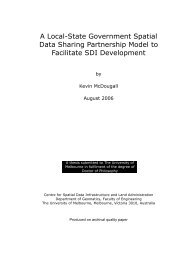Marine Cadastres - Challenges and Opportunities for Land Surveyors
Marine Cadastres - Challenges and Opportunities for Land Surveyors
Marine Cadastres - Challenges and Opportunities for Land Surveyors
Create successful ePaper yourself
Turn your PDF publications into a flip-book with our unique Google optimized e-Paper software.
Resolution 3 – Defining the Spatial Dimension of the <strong>Marine</strong> Environment<br />
Recommends that the term “marine administration system” is adopted <strong>for</strong> the<br />
administration of rights, restrictions <strong>and</strong> responsibilities in the marine environment, with<br />
the spatial dimension facilitated by the <strong>Marine</strong> SDI. And further recommends that a<br />
marine cadastre is defined as a management tool which spatially describes, visualises<br />
<strong>and</strong> realises <strong>for</strong>mally <strong>and</strong> in<strong>for</strong>mally defined boundaries <strong>and</strong> associated rights,<br />
restrictions <strong>and</strong> responsibilities in the marine environment as a data layer in a marine<br />
SDI, allowing them to be more effectively identified, administered <strong>and</strong> accessed.<br />
Resolution 4 – Requirement <strong>for</strong> Further Development of Guidelines <strong>and</strong> Tools to<br />
Administer the Spatial Dimension of the <strong>Marine</strong> Environment.<br />
Recommends that PCGIAP further investigates <strong>and</strong> develops guidelines <strong>and</strong> tools <strong>for</strong><br />
administering the spatial dimension of the marine environment.<br />
Resolution 5 – Expression of Gratitude to the Malaysian Government.<br />
The University of Melbourne research team is now analysing the results of the<br />
workshop as well as publishing online, all country reports presented at the workshop.<br />
The template <strong>for</strong> country reports is also available online <strong>and</strong> other countries are invited<br />
to complete the template <strong>and</strong> <strong>for</strong>ward it to the team to further strengthen the project<br />
outcomes. The web address <strong>for</strong> both the template <strong>and</strong> results is:<br />
http://www.geom.unimelb.edu.au/maritime/PCGIAPWorkshop.htm. The team also<br />
recently designed <strong>and</strong> created a dedicated website (www.marineadministration.org) <strong>for</strong><br />
marine administration in which all completed country templates are available with other<br />
related materials. This website will be the main portal <strong>for</strong> these activities through<br />
PCGIAP in the future. Discussions are under way to collaborate with Commission 4<br />
(Hydrographic Surveying) of the International Federation of <strong>Surveyors</strong> in extending the<br />
number of countries participating in this initiative.<br />
MARINE SDI AND CADASTRE RESEARCH IN AUSTRALIA<br />
Initial support <strong>for</strong> marine cadastre research in Australia came in late 2001 with the<br />
awarding of an ARC Linkage-Projects grant to a team comprising the University of<br />
Melbourne, GeoFix Pty Ltd, L<strong>and</strong> Victoria (LV), Geoscience Australia (GA) <strong>and</strong> the<br />
Queensl<strong>and</strong> Department of Natural Resources <strong>and</strong> Mines (NR&M). In addition to the<br />
work <strong>and</strong> contribution being made directly by the ARC project, a number of other<br />
initiatives (mainly Government) have commenced <strong>for</strong> example the National Oceans<br />
Office has started regional marine planning <strong>for</strong> Australia’s marine jurisdiction, <strong>and</strong> also<br />
the development of an Oceans Portal. Thus marine cadastre research in Australia has<br />
gained strong government support. Healthy coordination of the research ef<strong>for</strong>t is being<br />
maintained through the nurturing of close collaborative links between the government<br />
<strong>and</strong> academic sectors, while keeping the private sector fully in<strong>for</strong>med of developments.<br />
Progress on the ARC <strong>Marine</strong> Cadastre Project<br />
The above ARC project <strong>for</strong>mally commenced in June 2002, with the appointment of two<br />
postgraduate students <strong>and</strong> a full-time research assistant. The project ran <strong>for</strong> two years<br />
finishing with a seminar in June 2004 <strong>and</strong> had as its principle objective the definition of<br />
issues currently hindering the development of an Australian marine cadastre <strong>and</strong>, in that<br />
context, the establishment of a direction <strong>for</strong> future research.<br />
Research within the ARC project focussed on two areas. The first was a consideration<br />
of the similarities <strong>and</strong> differences between the existing l<strong>and</strong> cadastre <strong>and</strong> a future<br />
marine cadastre <strong>and</strong> the suitability <strong>and</strong> extension of the Australian Spatial Data<br />
Infrastructure (ASDI) to the marine environment. The second research area focused on







